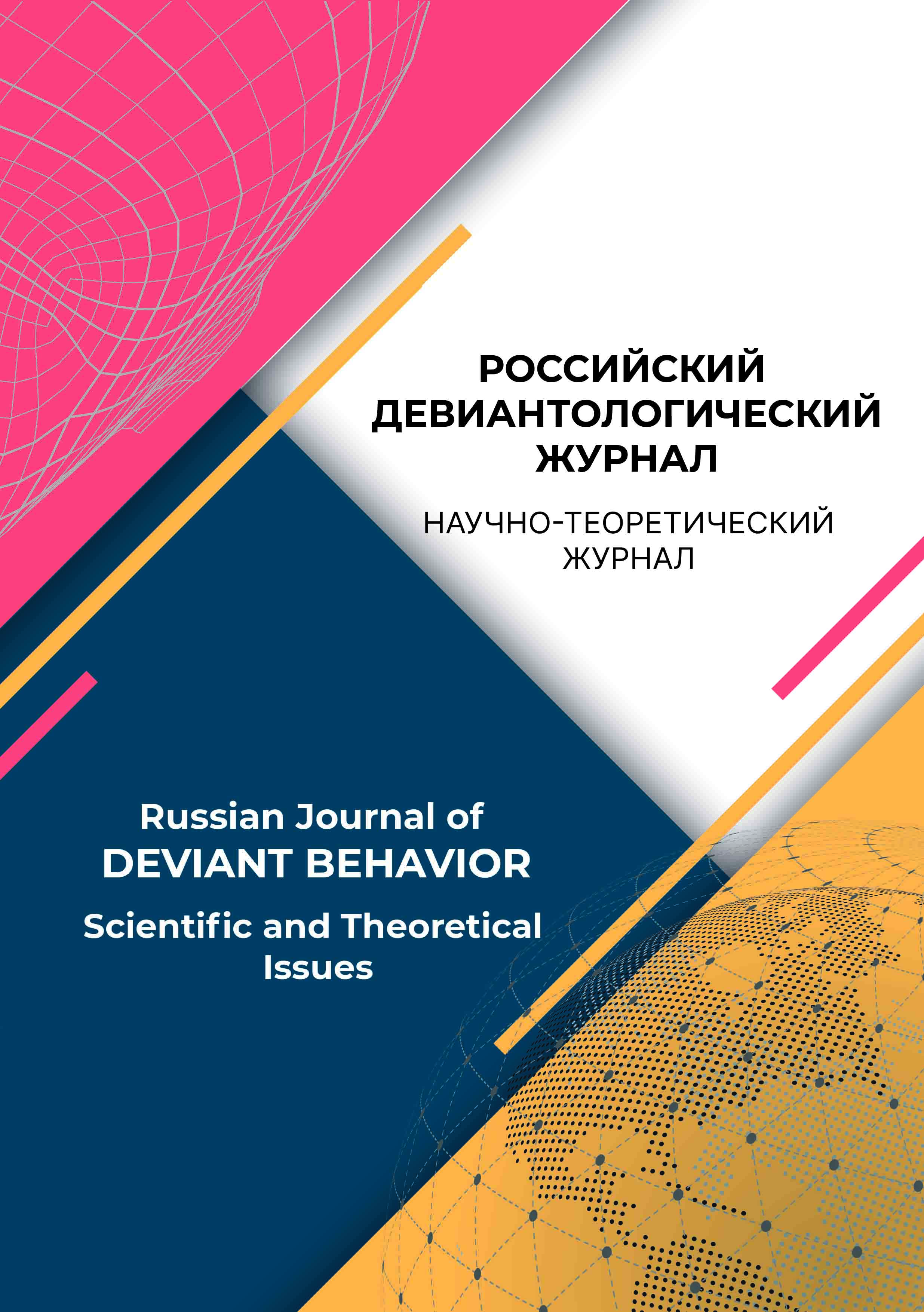Vsevolozhsk, St. Petersburg, Russian Federation
In article the personal risk factors and internal protective factors of the suicide behavior on an example of psychological features of the women who have made attempted suicide (n=40, age 38,6±5,1 years), in comparison with control group are considered. The relevance of the study is due to the need to predict the commission of repeated suicide attempts, as well as the urgency of psychocorrective and psychotherapeutic assistance. Methods of research: R. Kettell’s 16-factor personality questionnaire (16-FLO, form C), S. Rosenzweig’s test of drawing association (frustration reactions). Rosenzweig, P. I. Junatzkevich’s test «SR-45» (detection of propensity to suicidal reactions). Using an anonymous questionnaire, socio-demographic indicators were recorded: age, marital status, number of children, level of education and professional employment. Statistical analysis of empirical data was carried out in the program «SPSS Statistics, ver. 19.0» using Mann-Whitney U-criterion (p≤0.05) and Pearson’s r-correlation coefficient (p=0.05; p=0.01). As a result of the study, it was found that psychological risk factors for suicidal behavior (in the context of the significance of the situation experienced), are socio-demographic and personal characteristics: loneliness, lack of work; reticence, secrecy, aloofness, non-sociability, emotional lability, impulsivity, weak willful self-control, pessimism, anxiety, social passivity, non-self-sufficiency, need for support from others, timidity, dependence, low self-esteem, willingness to take the blame for themselves, not In individual work, it is necessary to work through current and past traumatic experiences, using an integrative approach (methods of body-oriented, cognitive-behavioral, existential and Gestalt therapy, transactional analysis, techniques of neurolinguistic programming, etc.). After normalization of the somatic and emotional state, group psychotherapy is indicated, for example, in the form of training in communicative competence, self-esteem, stress-resistance, etc., in order to form constructive skills for resolving conflict situations and overcoming difficulties in life.
suicide, suicide, suicide attempt, suicidal behavior, suicidal factors, women, frustration
1. Aminov, I. (2021). Samoubijstva i ih profilaktika v Rossijskoj Federacii, 2021 god: osnovnye fakty. Demoskop Weekly, (911-912). URL: http://www.demoscope.ru/weekly/2021/0911/suicide.php
2. Bozhkova, E. D., Agafonova, A. I., Rytova, A. Yu. (2018). Faktory suicidal’nogo riska i zashchitnye faktory: strategiya predotvrashcheniya samoubijstv molodezhi. Nizhegorodskij psihologicheskij al’manah, 2, 36-44.
3. Vaulin, S. V. (2012). Suicidal’nye popytki i nezavershennye suicidy (gospital’naya diagnostika, optimizaciya terapii, profilaktika): avtoref. dis. … d-ra med. nauk. Moskow.
4. Orlova, N. A. (2015). Gendernye aspekty samoubijstv. Teoriya i praktika obshchestvennogo razvitiya, 20, 35-37.
5. Pichikov, A. A. (2015). Polovye razlichiya suicidal’nogo povedeniya u podrostkov (klinika, diagnostika, profilaktika recidivov): dis. … kand. med. nauk. Saint Petersburg.
6. Pomerlyan, A. N., Grigor’ev, O. V. (2020). Zhenshchiny Rossii v silovyh strukturah: motivy, problemy, perspektivy. Istoricheskaya i social’no-obrazovatel’naya mysl’, 12(2), 93-99. https://doi.org/10.17748/2075-9908-2020-12-2-93-99.
7. Repin, M. E., Serebrovskaya, D. D. (2018). Zhenshchiny v rossijskoj policii. V Rossijskaya policiya: tri veka sluzheniya Otechestvu: sbornik materialov yubilejnoj mezhdunarodnoj nauchnoj konferencii, posvyashchennoj 300-letiyu rossijskoj policii (23-25 aprelya 2018 goda, str. 1132-1134). Saint Petersburg: Sankt-Peterburgskij universitet MVD Rossii.
8. Strel’nikova, Yu. Yu. (2022). Psihologicheskie osobennosti zhenshchin, sovershivshih popytku suicida. V Psihologiya XXI veka: vyzovy, poiski, vektory razvitiya: sbornik materialov III Vserossijskogo simpoziuma psihologov s mezhdunarodnym uchastiem, posvyashchennogo 30-letiyu so dnya obrazovaniya psihologicheskogo fakul’teta Akademii FSIN Rossii (g. Ryazan’, 8-9 aprelya 2021 goda, str. 154-157). Ryazan’: Akademiya FSIN Rossii.
9. Appleby, L. (1996). Suicidal behaviour in childbearing women. International Review of sychiatry, 8. 107-115.
10. Czeizel, A. E. (2011). Attempted suicide and pregnancy. Journal of Injury and Violence Research, 3(1), 45-54. https://doi. org/10.5249/jivr.v3i1.77
11. Fehling, K. B., & Selby, E. A. (2021). Suicide in DSM-5: current evidence for the proposed Suicide Behavior Disorder and other possible improvements. Frontiers in Psychiatry, 11. https://doi.org/10.3389/fpsyt.2020.499980
12. Hill, N. T., Robinson, J., Pirkis, J., Andriessen, K., Krysinska, K., Payne, A., Boland, A., Clarke, A., Milner, A., Witt, K, Krohn. S., & Lampit, A. (2020). Association of suicidal behavior with exposure to suicide and suicide attempt: a systematic review and multilevel meta-analysis. PLoS Medicine, 17(3). https://doi.org/10.1371/journal.pmed.1003074.
13. Hua Wu, Liu Lu, Yan Qian, Xiao-Hong Jin, Hai-Rong Yu, Lin Du, Xue-Lei Fu, Bin Zhu, & Hong-Lin Chen. (2022). The significance of cognitive-behavioral therapy on suicide: An umbrella review. Journal of Affective Disorders, 317, 142-148. https://doi.org/10.1016/j.jad.2022.08.067
14. Ivey-Stephenson, A., Crosby, A., Hoenig, J., Gyawali, S., Park-Lee, E., & Hedden, S. (2022) Suicidal Thoughts and Behaviors Among Adults Aged ≥18 Years - United States, 2015-2019. MMWR Surveillance Summary. U.S. Department of Health and Human Services, 71(1), 1-19. https://doi.org/10.15585/mmwr.ss7101a1
15. Lin, W., Wang, H., Gong, L., Lai, G., Zhao, X., Ding, H., & Wang, Y. (2020). Work stress, family stress, and suicide ideation: a cross-sectional survey among working women in Shenzhen, China. Journal of Affective Disorders, 277, 747-754. https://doi.org/10.1016/j.jad.2020.08.081
16. Marzuk, P. M. (1997) Lower risk of suicide during pregnancy. American Journal of Psychiatry, 154(1), 122-123. https://doi.org/10.1176/ajp.154.1.122
17. Meurk, C., Wittenhagen, L., Lucke, J., Barker, R., Roberts, S., Moss, K., Waterson E., & Heffernan E. (2021) Suicidal behaviours in the peripartum period: a systematic scoping review of data linkage studies. Archives of women’s mental health, 24(4), 579-593. https://doi.org/10.1007/s00737-021-01102-x.
18. Qin, P. Agerbo, E., Westergard-Nielsen, N., Eriksson T., & Mortensen, Pr. Bo (2000). Gender differences in risk factors for suicide in Denmark. The British Journal of Psychiatry, 177(6), 546-550. https://doi.org/10.1192/bjp.177.6.546
19. Osborn, E., Brooks, J., O’Brien, P., & Wittkowski, A. (2021). Suicidality in women with Premenstrual Dysphoric Disorder: a systematic literature review. Archives of women’s mental health, 24 (2), 173-184. https://doi.org/10.1007/ s00737-020-01054-8
20. Weissa, S.J., Simeonova, D.I., Koleva, H., Muzikd, M., Clarke, K.D., Ozerdem, A., Cooperg, B., & Ammerman, R.T. (2022) Potential paths to suicidal ideation and suicide attempts among high-risk women. Journal of Psychiatric Research, 155(8), 493-500. https://doi.org/10.1016/j.jpsychires.2022.09.033














